 Before and after Juniper by Bonsai Mike made quick and easy (or at least quick). Here's part what Mike wrote about this tree and the event where the transformation took place... "I’d like to thank the Puget Sound Bonsai Association for bringing me up to Seattle... Here’s a before and after of my demo tree. Deadwood still needs to be finished."
Before and after Juniper by Bonsai Mike made quick and easy (or at least quick). Here's part what Mike wrote about this tree and the event where the transformation took place... "I’d like to thank the Puget Sound Bonsai Association for bringing me up to Seattle... Here’s a before and after of my demo tree. Deadwood still needs to be finished."
Yesterday we featured a before and after by Bonsai Mike. Today, we’ve got another of Mike’s B&As. Both are junipers and both are impressive in their own right. After that, most similarities end. Yesterday’s was a monster yamadori where the process spanned five years. Today’s spanned hours
Continued below…

Before. Good stock, but plenty to do to get from here to after
Continued from above…
Transforming a tree in a few hours requires vision, quick decisions and technical competence. Experienced bonsai artists usually pull it off with flying colors, but there are no guarantees (the material they start with has a lot to do with the end result). In this case, the result speaks for itself

After. Not bad, especially considering it only took a few hours

Sierra juniper (Juniperus occidentalis), before and after by Bonsai Mike. You can see the potential peeking out underneath the foliage in the before shot. Still, an impressive transformation
Today’s tree belongs to Bonsai Mike, a first timer here on Bark (as distinguished from Michael Bonsai, who has appeared here numerous times). Here’s what Mike wrote about this old yamadori juniper… “One of my best trees. I collected this Sierra in 2011. It has gone through 3 stylings since then and keeps improving. The foliage is getting a little heavy now. In order to show greater age, some branches must be removed in order to create more open space.”
–

Before. I cropped off the edges in the B&A photo for a better fit. Here's the uncropped version

Further along...

Mike put up several after shots. This one presents a good picture of the living veins

Two legged beast. Shot at night

Another night shot.
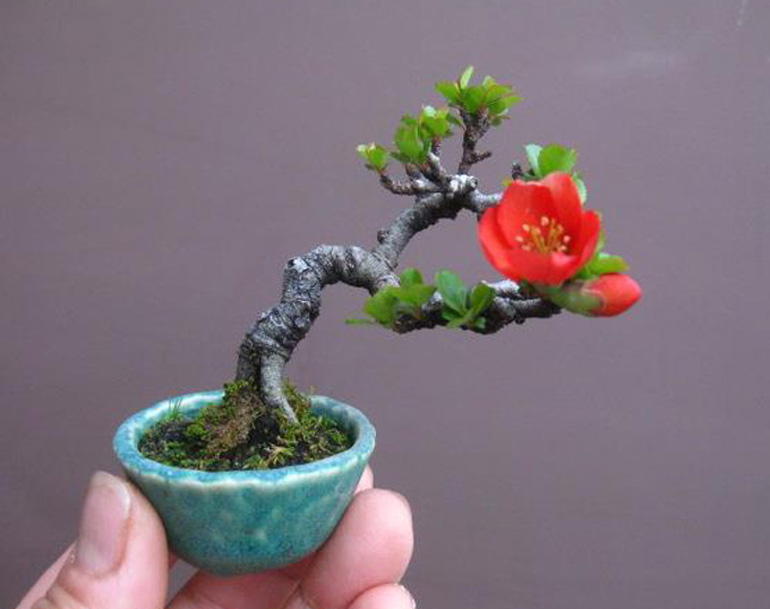
This little Japanese quince (Chaenomeles speciosa) looks old and yet is so small. I know I've mentioned this before, but there's something about the brilliance and purity of quince flowers.
Let’s make it three straight for Haruyosi, a favorite here and anywhere people love small trees. This isn’t the first time for this post (nor is it the second time). Must be one of our favorites.
–

Here's Haruyosi's caption... "This cherry tree 'Okame' bloomed half a month earlier than last year. (Prunus incamp cv. Okame)"


Prunus mume. I like this shot with just a touch of the pot showing
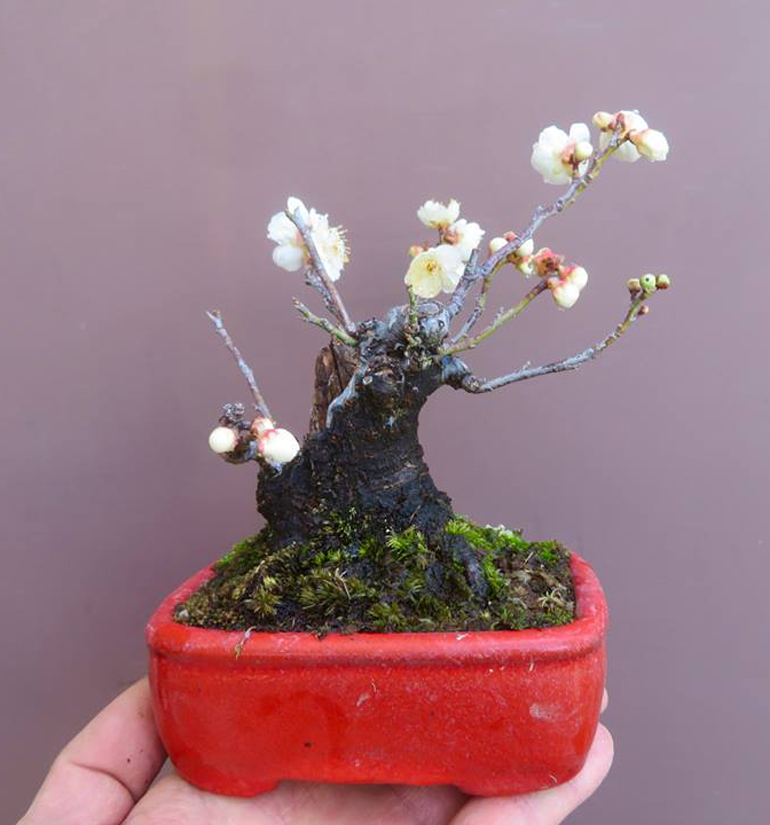
Red is the new black! Here the whole tree in its brilliant red pot. Red pots have long been uncommon with bonsai, the glaze is expensive and such a strong color can distract from even the most brilliant tree. But now, in this age of daring colors, red pots are popping up everywhere
–
 More delicate spring beauty. This time the pot is yellow. It turns out that, like red pots, yellow pots haven't been all that common but that may be changing too. The tree is Malus halliana (Hall's crapapple).
More delicate spring beauty. This time the pot is yellow. It turns out that, like red pots, yellow pots haven't been all that common but that may be changing too. The tree is Malus halliana (Hall's crapapple).
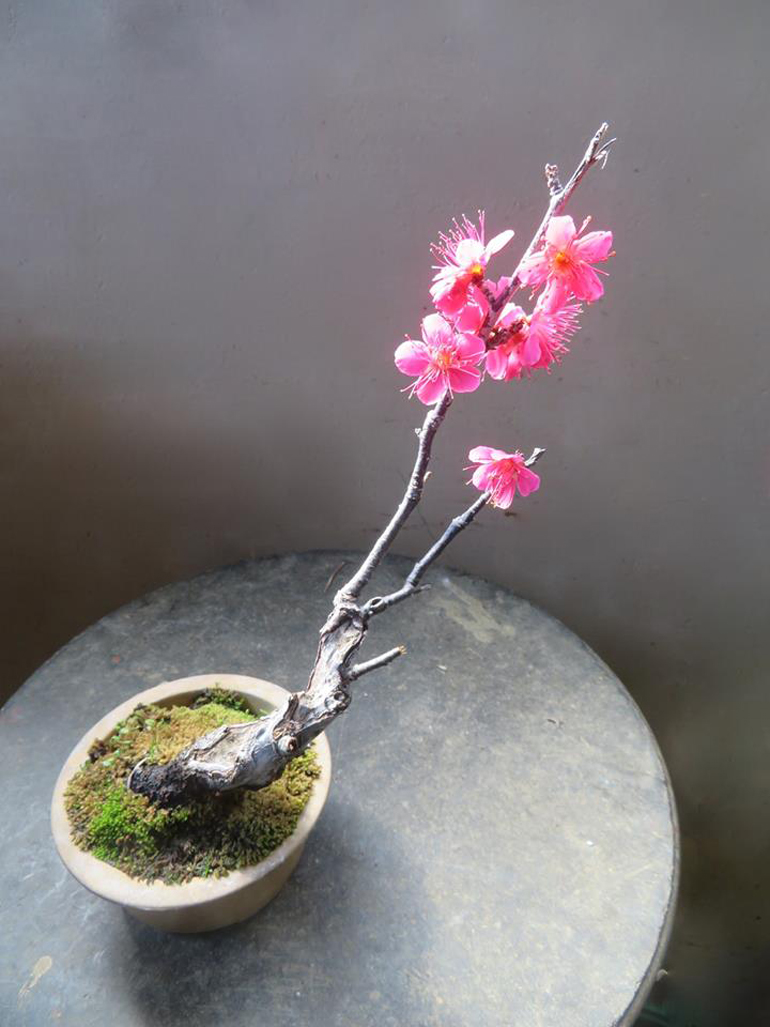
Another Prunus mume
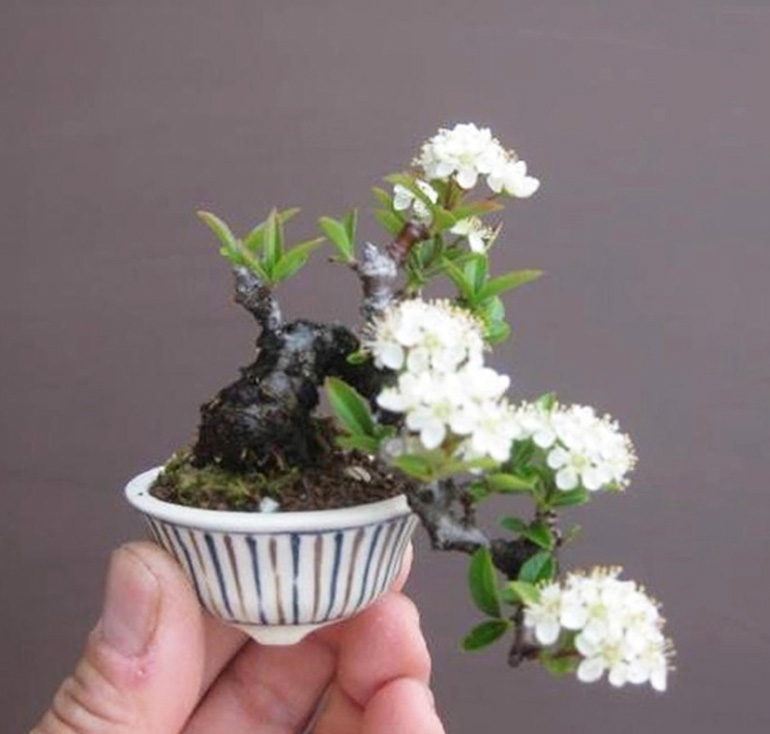
I think this one qualifies as Mame ('bean' in Japanese), a common word for the smallest bonsai. Both the tree (Pyracatha) and pot are by Haruyosi.
 Just another of Haruyosi's masterpiece pots. Red and yellow together, but I guess you probably noticed.
Just another of Haruyosi's masterpiece pots. Red and yellow together, but I guess you probably noticed.

Shimpaku juniper with stand and stone in a show display. I know the tree is Haruyosi's and I'm pretty sure the pot is also his. I'm not sure about the stand, though I wouldn't be surprised if Haruyosi made it
Continuing where we left off with Haruyosi’s small bonsai. If you want more, you can enjoy a wealth of great photos on Haruyosi’s fb site and here on Bonsai Bark as well
Continued below…
SPECIAL ENDS TONIGHT

Another small Shimpaku. This too is part of a show display, but I cropped it to focus on the tree. You can see the original on his fb post
Continued from above…
I’ve become inspired by Haruyosi to try field growing small bonsai. Especially Shimpaku, which do well here in northern Vermont. However, the biggest issue is time; it takes forever for trees to develop here with our short growing seasons. I’ve got some that have been in the ground for 7 or 8 years (maybe longer) that could still use a few more years
 Haruyosi's pots have become more ornate lately. If you look at some of our earlier Haruyoshi posts (here), you'll see much simpler pots
Haruyosi's pots have become more ornate lately. If you look at some of our earlier Haruyoshi posts (here), you'll see much simpler pots
 Trident maple in full fall color
Trident maple in full fall color
 The sacrifice branch on this little pine is there to strengthen the apex
The sacrifice branch on this little pine is there to strengthen the apex

Mission accomplished

Another ornate pot
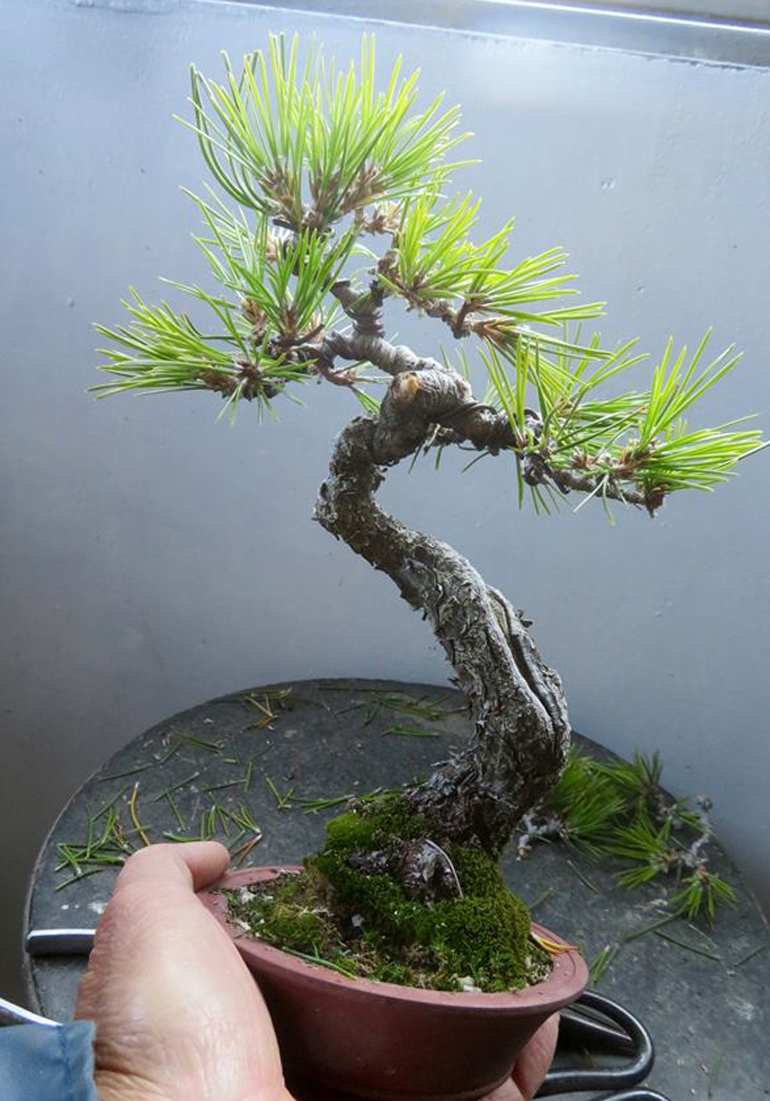
Pines seem to be Haruyosi's favorites

The trunk speaks of age on this one. You might notice that some fairly significant branches have been removed
ENDS TONIGHT, DECEMBER 4TH AT 11:59PM EST

–
SPECIAL ENDS TONIGHT, TUES, DECEMBER 4th at 11:59pm EST
Roshi Tools are famous for quality, durability, beauty & reasonable prices
FREE Shipping Still Applies
on Continental U.S. orders 75.00 or more
but only if you select Free Shipping when you check out
–

Haruyosi Shohin pine with a twist
Continuing with yesterday’s small bonsai theme… Today it’s our old friend Haruyosi, a highly accomplished and prolific small bonsai and small pot artist. None of today’s photos have been shown here before. If you want more, you can enjoy a wealth of great photos on Haruyosi’s fb site and here on Bonsai Bark as well.
–

No identification is provided, but this one looks like a Crabapple
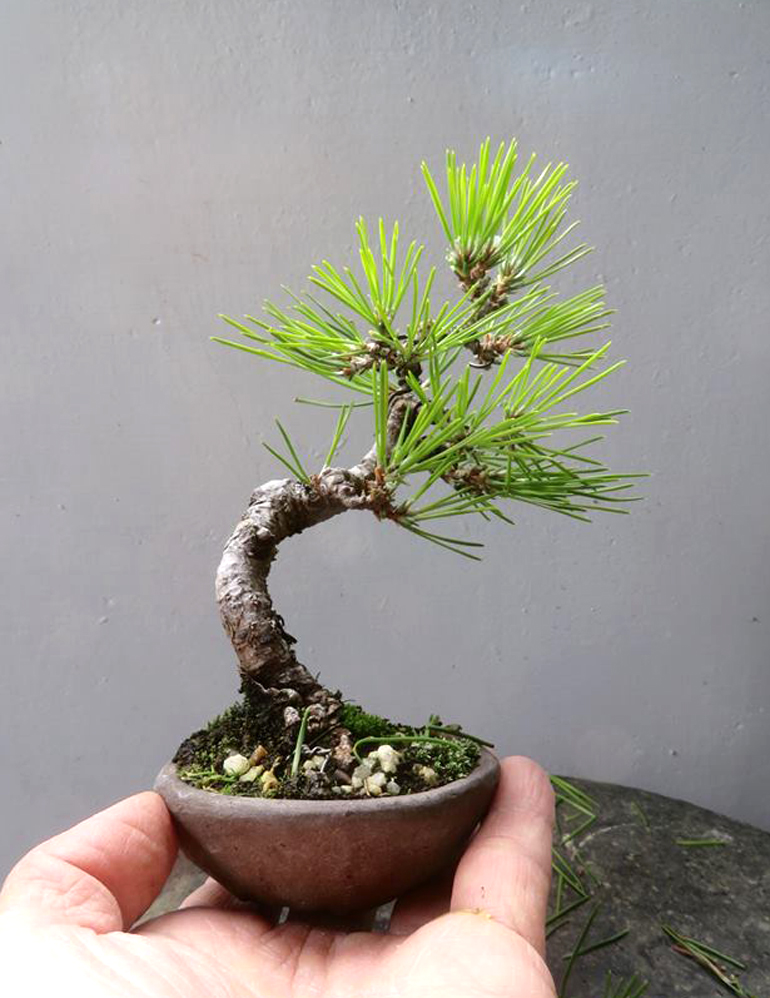
You can see clearly that this is a two needle pine. Both Japanese black pines and Japanese red pines (Pinus densiflora) have two needles per fascicle, but black pines are much more popular, so that would my guess
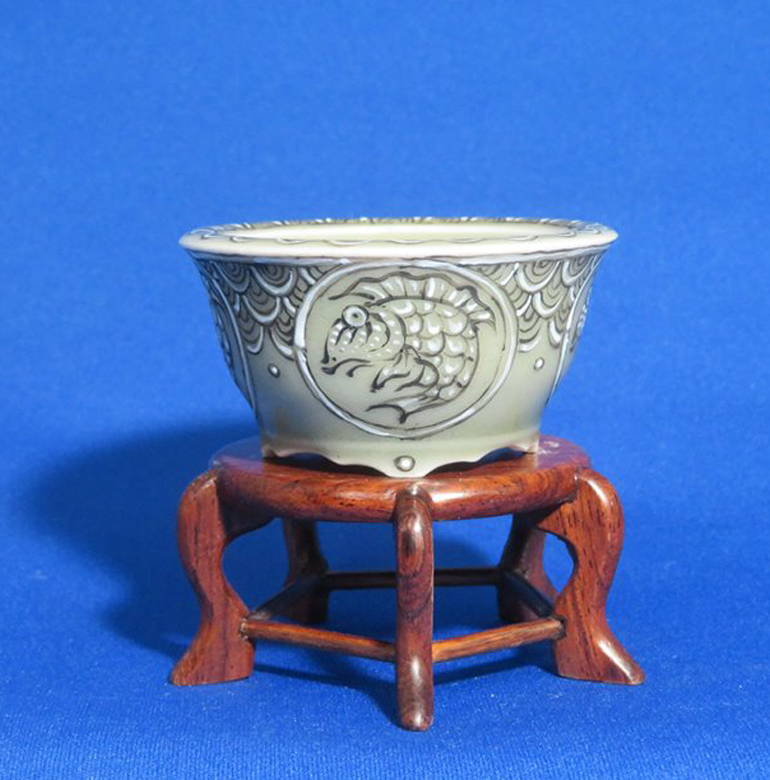
Haruyosi makes his own pots
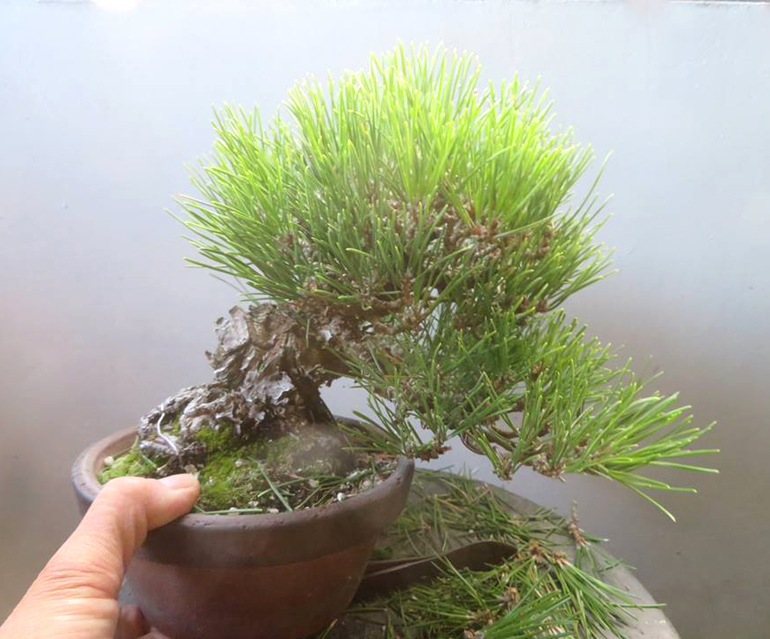
You don't see small pines with this much character every day. As you can see, the needles have just been thinned, but it looks like more need to come off

Twisted. Looks like a little Shimpaku

Apologies for the fuzz. I cropped the original for a closer look at the details

This little deciduous tree with its profusion of small orange fruit isn't identified, so we can only guess. Based on the fruit and the bark we'll try Crabapple. If we're wrong and you know what it is (or think you do) you can put it in the comments on our timeline.
Short trees and short time today, which is why we’ll take that easy way out and bring back a favorite from our archives. This one originally appeared almost exactly one year ago (Dec 5th, 2017). I’ve long had a soft spot for Shohin bonsai and these are some of my favorites
Continued below…

We don't have to guess this time. Here's the caption... "Japanese Beautyberry on display at the 33rd Taikan-ten in Kyoto, Japan."

Here's one that is attributed to the artist. It's a Juniper by Haruyoshi, who happens to be one of our favorites. So much so, that I'm sure we've shown this very tree. Maybe even more than once.

Piled up Pyracantha (Firethorn)

This burly little beast is a Japanese black pine

Japanese white pine

This tiny one says "BlackPine-at-Taisho-en"

Can't tell if this Gardenia qualifies as a Shohin (no dimensions given) but either way it's great tree in a sweet little pot. Nice stand too

No identification is given with this tree, but it looks like it could be a Yew (Taxus)
Continuing with two more of David Benavente’s bonsai that are featured on a fb site called Una siesta in el nebari (A nap in the nebari)
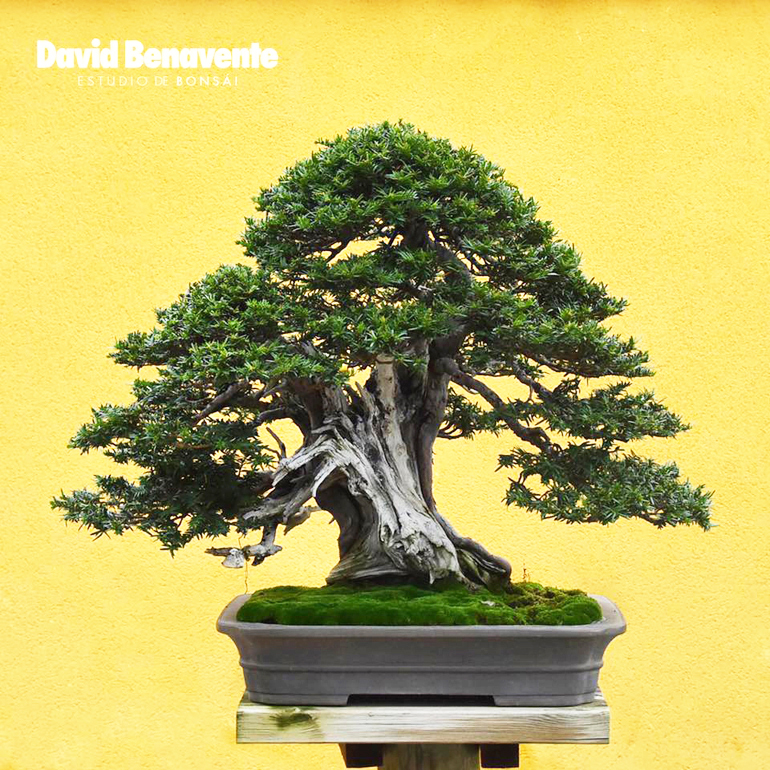
The uncropped original of the tree above

Another yew?

Another uncropped original.

As you can see, this muscular bonsai belongs to David Benavente, one of Europe's best know bonsai artists. The tree isn't identified on our source, but it looks a lot like a Japanese white pine
Today we’ve got a quick study of two David Benavente’s pines. We’ve long been impressed with David’s bonsai and have featured them many times here on Bonsai Bark. I found these photos on a fb page titled Una siesta in el nebari (A nap in the nebari)
Continued below…

Few things lend as much age (or impression of age) as well developed bark. And it's an honest, hard to fake impression; bark is only looks old when it is old. Nebari is another feature the adds to this impression, and though this nebari isn't overwhelming, it's pretty good for a pine
Continued from above…
We’ll allow for poetic license when it comes to the title, A nap in the nebari. And just in case you aren’t familiar, Nebari is a Japanese word that refers to the base of a bonsai trunk, where exposed surface roots flare out. Both trees shown here have somewhat modest nebari, which is to be expected with pines (unlike some maples for example, which can have very dramatic nebari)
 Another muscular pine that also looks like a Japanese white
Another muscular pine that also looks like a Japanese white

Given the impressive bark, there's no denying the age on this tree. And like the tree above, it has a well developed nebari (for a pine, at least)

Windswept bonsai are few and far between. Especially really good ones like this. It's not just a question of pointing everything in one direction. It must be done in a way that's convincing. This involves keen observation and considerable skill
We haven’t seen many bonsai from India, but if these trees are representative, I’m impressed. Beyond impressed really, they are that good. They were posted by Sanjay Dham. No varieties are given.

On the surface, literati (bunjin) bonsai seem simple enough. But it's really about feeling and subtlety. Like the windswept tree above, a literati has to be convincing in its naturalness

Strength, balance, taper (all the way out to the twigs) are a big part of what makes this tree so compelling. And then there are those uro (holes in the trunk) that add age and character

Three trunk or one? Either way, it's a monster with its massive base. The twisted twigs look like they were wired, but I suspect they grow that way (you don't often see wiring on tropical bonsai)
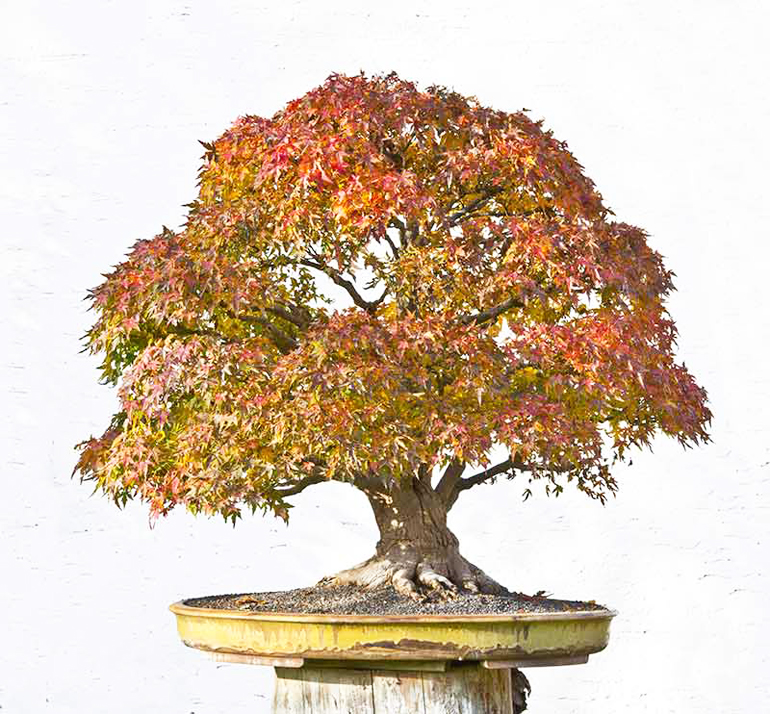 Defying convention and coming out with flying colors. Walter Pall repotted this maple during the heat of mid-summer and it didn't even blink
Defying convention and coming out with flying colors. Walter Pall repotted this maple during the heat of mid-summer and it didn't even blink
Just back from a long trip late last night, with plenty of catching up to do, so we’ll keep it simple by rerunning yesterday’s post.
 As long as we’re on Walter and Japanese maples, here one of my favorites from a post we did back in October, 2016. It’s also about repotting, so you might want to take a look.
As long as we’re on Walter and Japanese maples, here one of my favorites from a post we did back in October, 2016. It’s also about repotting, so you might want to take a look.


 Before and after Juniper by Bonsai Mike made quick and easy (or at least quick). Here's part what Mike wrote about this tree and the event where the transformation took place... "I’d like to thank the Puget Sound Bonsai Association for bringing me up to Seattle... Here’s a before and after of my demo tree. Deadwood still needs to be finished."
Before and after Juniper by Bonsai Mike made quick and easy (or at least quick). Here's part what Mike wrote about this tree and the event where the transformation took place... "I’d like to thank the Puget Sound Bonsai Association for bringing me up to Seattle... Here’s a before and after of my demo tree. Deadwood still needs to be finished."












 More delicate spring beauty. This time the pot is yellow. It turns out that, like red pots, yellow pots haven't been all that common but that may be changing too. The tree is Malus halliana (Hall's crapapple).
More delicate spring beauty. This time the pot is yellow. It turns out that, like red pots, yellow pots haven't been all that common but that may be changing too. The tree is Malus halliana (Hall's crapapple).

 Just another of Haruyosi's masterpiece pots. Red and yellow together, but I guess you probably noticed.
Just another of Haruyosi's masterpiece pots. Red and yellow together, but I guess you probably noticed.

 Haruyosi's pots have become more ornate lately. If you look at some of our earlier Haruyoshi posts (
Haruyosi's pots have become more ornate lately. If you look at some of our earlier Haruyoshi posts ( Trident maple in full fall color
Trident maple in full fall color The sacrifice branch on this little pine is there to strengthen the apex
The sacrifice branch on this little pine is there to strengthen the apex

























 Another muscular pine that also looks like
Another muscular pine that also looks like 




 Defying convention and coming out with flying colors. Walter Pall repotted this maple during the heat of mid-summer and it didn't even blink
Defying convention and coming out with flying colors. Walter Pall repotted this maple during the heat of mid-summer and it didn't even blink As long as we’re on Walter and Japanese maples, here one of my favorites from a post we did back in October, 2016. It’s also about repotting, so
As long as we’re on Walter and Japanese maples, here one of my favorites from a post we did back in October, 2016. It’s also about repotting, so 